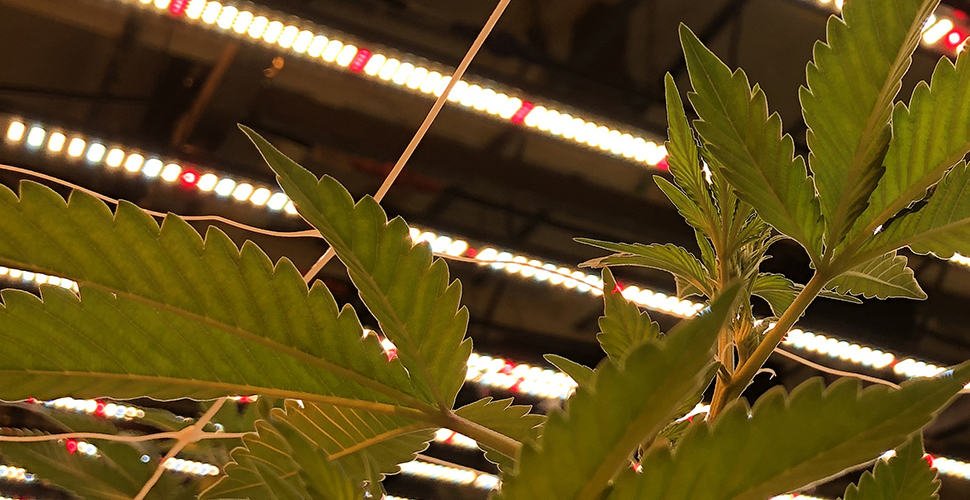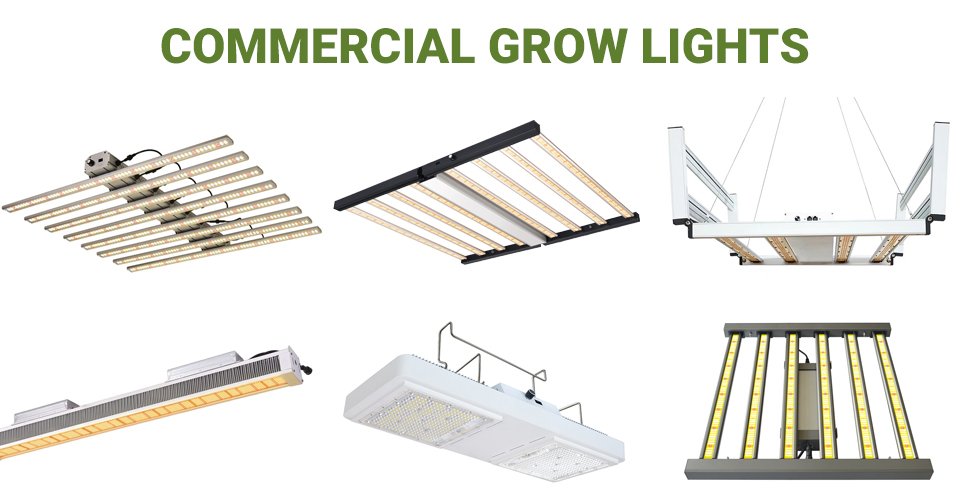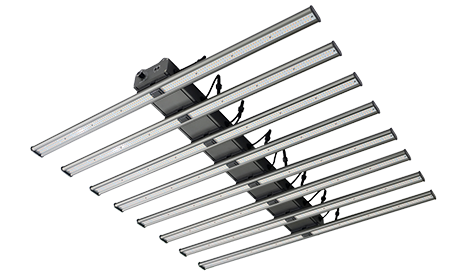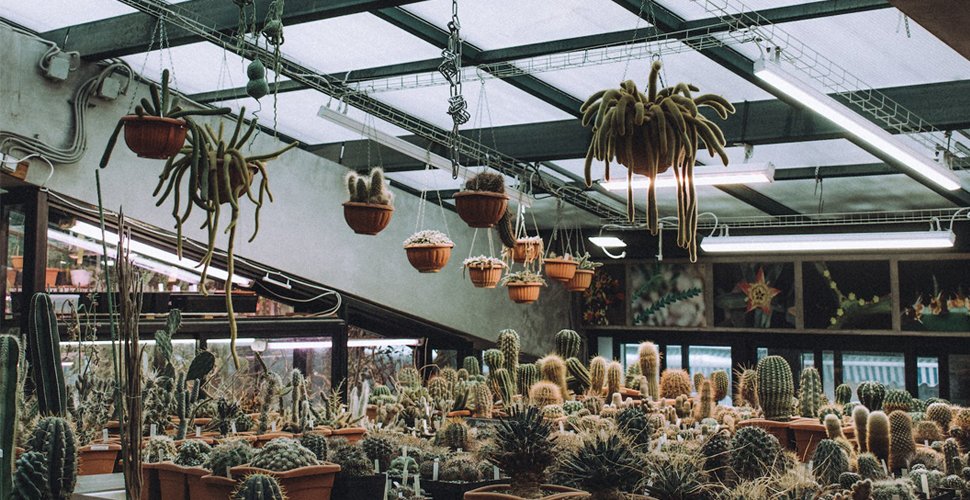Entre las muchas luces para plantas, la luz LED para cultivo es una de ellas, y también es una de las luces para plantas más utilizadas en los últimos años. En comparación con otras luces para plantas, las luces LED para cultivo tienen más ventajas, como menos calor, ocupan menos espacio, bajo consumo de energía, etc.
Con una comprensión más profunda de cómo funcionan las luces LED de cultivo, comprenderá cómo las luces LED para plantas pueden tener un gran impacto positivo en las plantas de interior.
Hay algunos datos claros que muestran que las luces LED para plantas tienen el efecto de aumentar el rendimiento y la cantidad, el lanzamiento temprano al mercado y la mejora de la calidad para la reposición de cultivos. Por eso cada vez más personas optan por utilizarlos.
La mayoría de las empresas de iluminación para horticultura afirman que sus luces de cultivo LED comerciales tienen una construcción única, un diseño espectral o una garantía prolongada para proporcionar la mejor luz de cultivo para el crecimiento de las plantas. Y te dirán con confianza, “¡Hemos descifrado el código para que sus plantas produzcan alta calidad!”
El problema es que ningún fabricante comercial de luces de cultivo LED puede garantizar que su producto brinde a las plantas la mejor luz de crecimiento en cada entorno.
Como sabemos, Diferentes tipos de plantas necesitan diferentes espectros para prosperar.. Incluso diferentes especies de la misma planta pueden responder de manera diferente al espectro.
Sin embargo, en la actualidad, las luces de cultivo LED disponibles en el mercado son básicamente iluminación de espectro completo. El espectro completo es para simular la luz solar, que es adecuada para todas las plantas. Si necesita una plantación más refinada, puede personalizar el espectro para plantas específicas.
En este artículo, exploraremos los tipos de luces de cultivo LED comerciales disponibles y le brindaremos consejos sobre cuáles es la mejor para comprar. Tenemos algunas sugerencias para su referencia sobre cómo elegir las luces de cultivo LED adecuadas y esperamos que estos consejos puedan ayudarlo.
Diferentes tipos de luces de cultivo LED
Si no está familiarizado con el maravilloso mundo de las luces de cultivo LED, es posible que no sepa cuál es la adecuada que necesita. Hay tantos tipos de luces de cultivo para plantas de interior que deslumbran a los consumidores.
Antes de presentar el rendimiento de las luces LED para plantas, comprendamos el diferentes tipos de luces de cultivo. Luego, podrá volver a realizar una selección precisa según su tipo de objetivo.
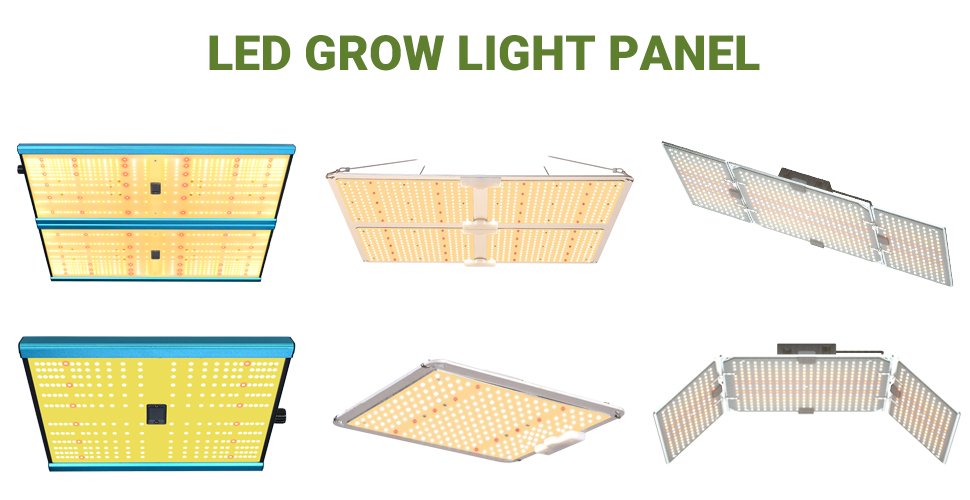
Panel de luz LED de cultivo
Aplicación: cultivo de interior, cultivo doméstico, tiendas de campaña y pequeños invernaderos.
Ideal para cultivar cannabis, diversas frutas y verduras como tomates, pepinos, pimientos, lechugas, fresas y flores.
Luz de cultivo LED comercial
Aplicación: salas de plantación a gran escala, cultivo hidropónico, granjas verticales comerciales, tiendas de cultivo e invernaderos.
La mayoría de los tipos comerciales de luces para plantas se utilizan para cultivar cannabis.
Porque pueden ofrecer más flexibilidad y personalización a los cultivadores de cannabis al permitirles ajustar los parámetros de luz según las necesidades y preferencias específicas de las diferentes cepas y etapas de crecimiento.
Marca y modelo de chips LED
Cuando la mayoría de las personas buscan una luz LED para cultivo de plantas, se centran en la potencia de la lámpara. Sin embargo, quiero decirles que el chip LED en sí es más importante que la potencia de la luz de crecimiento de la planta. Cuanto mejor sea la marca del chip, mejor será su proceso de fabricación, eficiencia, salida de luz y confiabilidad.
Los principales chips de luz de cultivo LED del mercado actual son Samsung y Osram.
contarte brevemente sobre Samsung 3030(LM301) Chips de la serie LED LED como ejemplo. Incluye modelos denominados LM301H, LM301B, LM301D y LM281.
- LM301H y LM301B son chips LED con PPE muy alto, el PPE puede alcanzar hasta 2,7 μmol/j o más.
- LM301D y LM281 ofrecen EPI ligeramente más bajos.
- Samsung LM301H y LM301B son adecuados para presupuestos muy elevados y para cultivos comerciales a gran escala.
- LM301D y LM281 son adecuados para presupuestos bajos, solo para cultivos a pequeña escala
La tecnología de empaque de luz de cultivo LED es muy madura, algunos fabricantes de empaques chinos también pueden lograr un rendimiento cercano al de los chips LM301B y LM301D, pero el costo es menor, como el LEDSTAR 303H y 302H.

La corriente del Chip
Las perlas LED deben garantizar una excelente disipación del calor. Dado que el calor no es bueno para los chips LED, las altas temperaturas pueden acortar la vida útil de los chips LED y provocar atenuación de la luz.
Para la mayoría de los chips LED de 200 mA a 300 mA, el PPF de salida es el 86 % de 65 mA. Es decir, cuanto menor sea la corriente, mayor será la PPF de salida.
Una corriente alta genera calor elevado y un calor interno elevado conduce a una menor eficiencia del chip. La calidad espectral se deteriora y se produce una decadencia de la luz. En este momento, aunque tu luz siga siendo brillante, su rendimiento se verá muy afectado. Por lo tanto, no se puede usar el brillo o la potencia para juzgar los méritos de una luz de cultivo LED.
Uniformidad de PPFD
¿Qué son PPF y PPFD?
La razón por la que los lúmenes no son un buen valor es que son puramente un valor para los ojos humanos.. Y no te preocupes por cuántos lúmenes cultivar plantas en interiores.
Debemos entender claramente que las luces de cultivo no son para humanos, sino para plantas en crecimiento, y su luz se utiliza para la fotosíntesis.
Para medir la luz utilizada por las plantas, necesitamos calcular el número de fotones por segundo que se irradian a la superficie de la planta, llamado PPF (Flujo de Fotones Fotosintéticos), que se calcula en μmol/s.
Para calcular el FPP, primero necesita saber el EPI (Eficacia de fotones fotosintéticos) del chip LED, que le da una idea rápida de la eficiencia de toda la luz. PPE 2,5 μmol/j significa que es una luz LED eficiente para el cultivo de plantas.
La fórmula para calcular PPE y PPF es la siguiente: PPF = PPE x Potencia
Por ejemplo, la luz de cultivo LED Auxgrow GT05, que puede ser una Reemplazo 1:1 para accesorio HPS, tiene un PPE de 2,45 μmol/J y una potencia de 800W, entonces su PPF = 2,45 x 800 = 1960 μmol/s.
Por cierto, el 30 de noviembre de 2022, se lanzó el DLC (DesignLights Consortium) Requisitos técnicos de iluminación de plantas 3.0, una nueva versión de la política que entrará en vigor el 31 de marzo de 2023. La versión 3.0 aumenta el umbral de efectividad de iluminación de la planta (PPE) a un mínimo de 2,30 μmol/J, un aumento del 21 % sobre el umbral de PPE de la versión 2.1.
Este umbral de PPE establecido para iluminación de cultivo comercial es una mejora del 35 % con respecto al umbral de PPE de lámpara de sodio de alta presión de doble extremo de 1000 W.
En cuanto al valor del PPE, la luz de cultivo LED Auxgrow GT05 cumple con los requisitos de certificación DLC 3.0.
A continuación, podemos obtener la PPFD (densidad de flujo de fotones fotosintéticos). PPFD mide la densidad PPF en metros cuadrados (m2). Esto significa que puede estimar la cantidad de luz que puede recibir un área, lo cual resulta muy útil para los cultivadores.
La siguiente es una lista de estimaciones de PPFD para cultivadores de cannabis domésticos.
- Etapa de crecimiento de la planta: 400-600 μmol/m2s
- Etapa de floración: 600-900 μmol/m2s
Los productores comerciales necesitan un poco más de cosecha.
- Etapa de crecimiento de la planta: 800-1000 μmol/m2s
- Etapa de floración: 1000-1200 μmol/m2
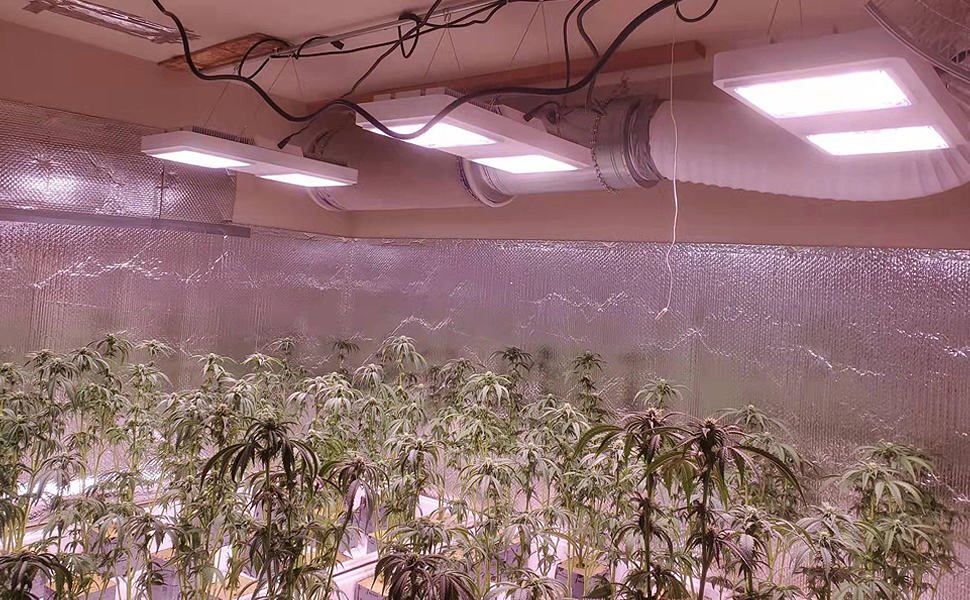
¿Por qué es importante la uniformidad del PPFD?
PPFD desigual significa que diferentes partes de la planta reciben diferentes cantidades de fotones, lo que también puede provocar un crecimiento desigual de la planta. En el mercado actual, las luces de cultivo LED Quantum Board no tienen un PPFD uniforme. Debes evitar el uso de luces de cultivo con PPFD alto en el medio y PPFD bajo en los bordes.
Para este problema de PPFD desigual, Fabricantes de luces de crecimiento vegetal centrados en R.&D Hemos diseñado nuevos paneles de luz LED para cultivo. El concepto de diseño es disponer los chips LED de forma dispersa y los chips circundantes densamente, asegurando así que el PPFD sea uniforme en todo el rango de irradiación de la luz.
Costo de electricidad de iluminación y producción por vatio
Después de que las luces LED para cultivo de plantas hayan reemplazado a la mayoría de las luces de cultivo HPS, muchos productores todavía eligen luces en función de la potencia. Ahora queremos que los productores cambien su enfoque de la potencia a los valores de PPFD. porque el El valor PPFD es una medida real de la cantidad de luz absorbida por la planta, no de la potencia.
Por ejemplo, la GT05 de 800W mencionada anteriormente, algunas personas pueden pensar que no produce tanta energía como una lámpara de 1000W. Sin embargo, puede alcanzar un valor de PPFD de 1444 μmol/m2s, que es casi equivalente al valor de PPFD emitido por una lámpara de planta HPS de 1000W.
Por lo tanto, aunque este reemplazo de LED HPS de 1000w tiene una potencia menor, Emite la misma energía fotónica que una luz de cultivo HPS de 1000w. Esto quiere decir que produce un efecto equivalente a 1000w HPS.
A largo plazo, invertir en un reemplazo LED de 800W para HPS de 1000w eventualmente se amortizará por sí solo, mientras que el sistema de 1000W terminará generando más costos de electricidad. Ya que un crecimiento completo de un sistema de 800W requiere 880 kWh, mientras que un sistema de 1000W requiere 1200 kWh por crecimiento.
Como productores preocupados por los ingresos, ¿por qué no eligen luces de cultivo LED cuyo funcionamiento cueste menos y produzcan los mismos resultados de crecimiento? Y tienen la ventaja de una larga vida útil y ahorro de costes en lámparas de repuesto.
¿Quiere obtener más información sobre el costo mensual de las luces de cultivo LED? Haga clic y vea detalles sobre Costo de la luz de crecimiento LED por mes.
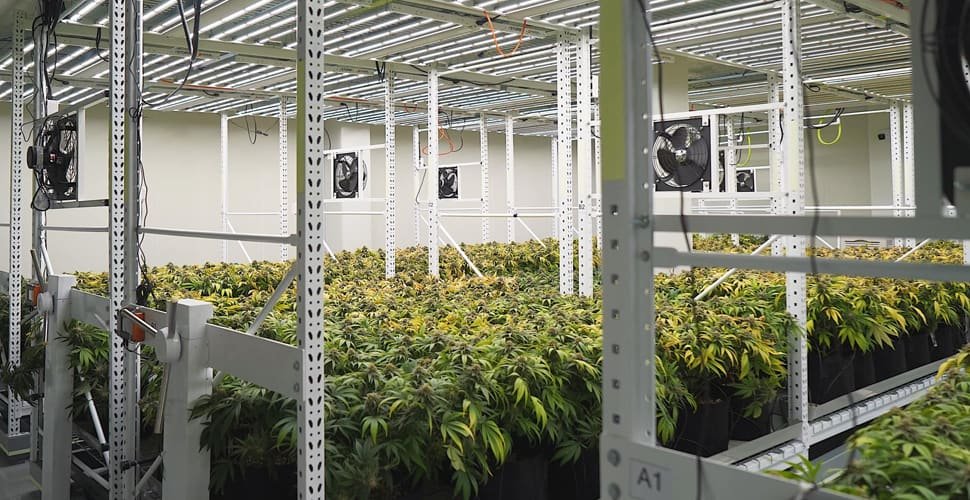
Comodidad de instalación
Las luces de cultivo LED se instalan sobre el dosel de la planta y la altura de instalación depende de la distancia entre el techo enrejado y las plantas. Al comprar luces LED para plantas, debe asegurarse de que las luces de cultivo se puedan instalar y reemplazar fácilmente. Lea nuestra publicación para aprender Cómo colgar luces de cultivo de interior para plantas.
En los invernaderos, la mayoría de las luces de cultivo comerciales para plantas se montan en postes que atraviesan la parte superior de la instalación. En los cuartos de cultivo de interior, es habitual utilizar colgadores, poleas unidas a postes o sujetas a soportes verticales para plantas.
Si va a construir un nuevo cobertizo para plantar, considere la facilidad de mantenimiento, atenuación, reemplazo y limpieza de las lámparas. ¿Quiere reemplazar sus viejas luces HPS? Luego considere si la ubicación de instalación original del HPS se puede instalar directamente con las nuevas luces LED.
Comodidad de la atenuación
La mayoría de las luces de cultivo LED no vienen con un regulador de intensidad ni una caja de atenuación. Cuando lo usas dentro de la tienda, no es un problema encenderlo o apagarlo. Pero si tienes que encender y apagar muchas luces al mismo tiempo, supondrá una enorme cantidad de trabajo y una pérdida de tiempo.
Nuestro consejo es intentar elegir luces LED para plantas con regulador de intensidad a la hora de elegir una. No sólo podrás encenderlo, aumentar su brillo y luego bajarlo o apagarlo según el patrón de crecimiento de la planta. Este proceso es como simular el amanecer y el atardecer del sol.
Auxgrow está desarrollando una Controlador de luz de cultivo LED basado en IoT, que se adapta a la caja de control de las principales marcas de iluminación LED comercial del mercado. Y puede conectarse con ellas a través de WiFi para controlar el encendido y apagado de hasta 200 luces de plantas, ajustando el brillo.
Si activa la función de temporizador, realizará ajustes de encendido y apagado y de brillo todos los días de acuerdo con la hora que establezca. Ya sea que esté en el invernadero o de vacaciones, puede controlar fácilmente sus luces LED de cultivo comerciales.
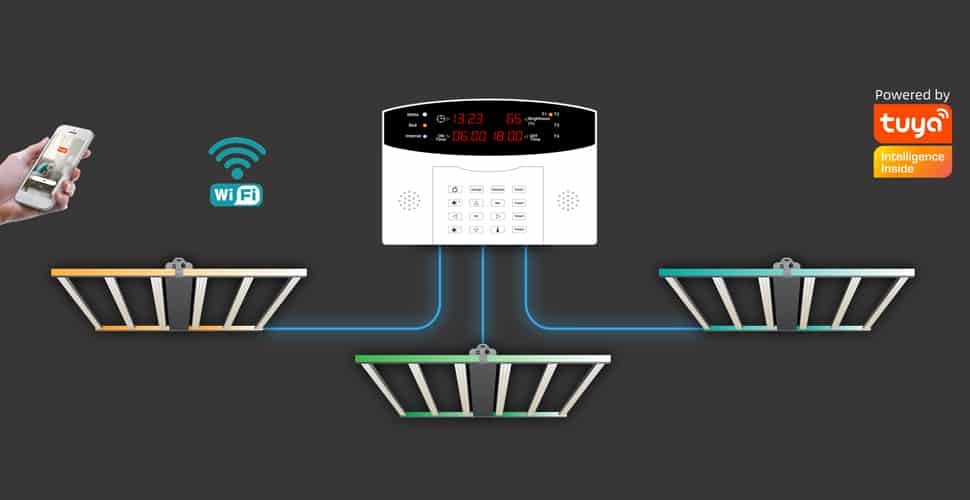
Marca de controlador LED
Problemas de calidad del sistema de iluminación LED de crecimiento, uno es el chip LED y el otro es el controlador LED.
Más de 100W de luces LED para plantas, todas con un controlador externo. La función principal del controlador es convertir energía de 110 V o 220 V de CA en energía de 50-60 V de CC.
Las marcas de controladores más conocidas que se utilizan habitualmente en las luces LED de cultivo comerciales son Mean Well, Sosen e INVENTRONICS, y no se puede negar que incluso las grandes marcas pueden tener sus pros y sus contras.
Buenas intenciones
Mean Well no tiene un controlador especial para las luces de las plantas. Pero sus series de controladores ELG y XLG para iluminación comercial, también las utilizan muchas fábricas de luces de cultivo LED para iluminación de plantas.
Recomendamos el controlador de la serie ELG. La mayor desventaja del controlador XLG es que cuando la temperatura alcanza los 40 grados o más, activa la autoprotección y deja de funcionar. Si es un verano caluroso, no puedes usarlo correctamente en absoluto.
Pinos
Sosen es una empresa profesional de controladores LED. Tiene productos de controlador especiales de luz de crecimiento LED, potencia disponible de 36 W a 800 W, rendimiento estable y calidad confiable.
INVENTRÓNICA
INVENTRONICS también es una empresa profesional de electrónica de controladores LED; como Mean Well, no existe un controlador LED especial. Pero sus controladores de alta potencia de 600 W y 800 W también se pueden utilizar en luces LED para plantas.
Consejos
- Desde la perspectiva del equilibrio entre costos y rendimiento, Sosen es una buena opción; muchos proveedores de luces LED para horticultura eligen Sosen.
- Si el presupuesto no es mucho, puede considerar otros controladores certificados por UL, como JUSON y Zhihe.
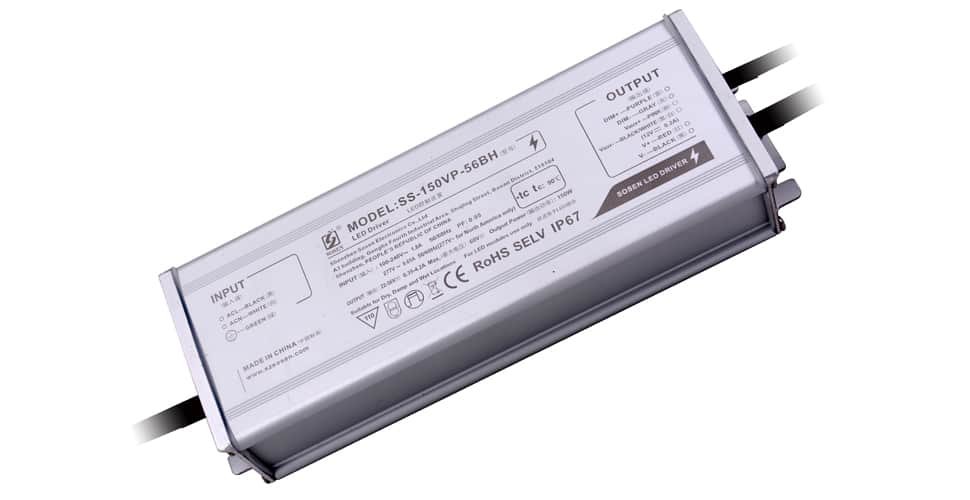
Resumen
Para los cultivadores domésticos con poca demanda, les sugiero que compren grandes marcas como Spider Farmer, Gavita, LUXX, etc.
Si es un distribuidor o minorista de luces de cultivo LED, los 7 puntos anteriores pueden ayudarle a elegir muy bien las luces de cultivo LED adecuadas.
Muchos fabricantes profesionales de luces de cultivo LED admiten la personalización. Puede envía tus requerimientos a Auxgrow y comunicarse con ellos de manera efectiva. Producirán de acuerdo con los requisitos razonables que usted establezca. Al mismo tiempo, también te darán sugerencias profesionales para tu referencia.
jayes
Como gerente de marketing digital en AUXGROW, Jayes combina la pasión por los sistemas hidropónicos y la experiencia en luces de cultivo LED. Con experiencia práctica y un profundo conocimiento, Jayes le guía a través del mundo del cultivo sostenible.

